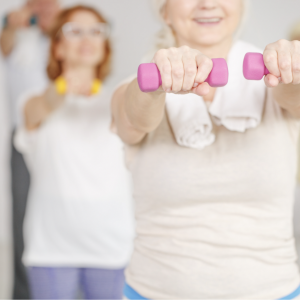The rotator cuff is a group of muscles which surround the shoulder joint and help keep your upper arm (the humerus) firmly attached to the shoulder socket. These muscles are small, but strong and powerful – and incredibly important! The rotator cuff muscles also help with abduction, which is moving the arm away from the body, as well as internal and external rotation of the shoulder (think of this as opening and closing a door, with your elbow being the door hinge). The four muscles of the rotator cuff are: Supraspinatus, Infraspinatus, Teres Minor and Subscapularis.
Many people report soreness through the shoulder joint, and this can make activities of daily living difficult. Soreness can be the result of wear and tear, injury, or repetitive strain. We need our shoulders to be strong and stable for a lot of daily movements – driving, vacuuming, hanging the washing etc.
Testing yourself for rotator cuff injuries
Of course, the most common way people realise there could be something wrong with their rotator cuff is pain or limitations when trying to perform a movement that was once second nature. For example, people feel their shoulders getting sore or tired when hanging out the washing.
Another way to check for any discrepancies in rotator cuff function is a quick Range of Motion (ROM) test. There are four main movements you want to test for:
- Abduction – moving your arm sideways away from your body
- Flexion – moving your arm away from your body in front of you
- Internal rotation – bend at the elbow, tuck your elbow into your ribs and move your hand/fist in towards your stomach
- External rotation – bend at the elbow, tuck your elbow into your ribs and move your hand/fist away from your body (like opening a door)

As you do each of the above, note if there is any pain or stiffness, and at which point of the movement they occur.
Manual muscle tests and scans can also be conducted to further see what muscles and/or nerves could be involved. We suggest booking in to see a trained therapist for these.
Strengthen and stretch the rotator cuff
Strength exercises for the rotator cuff muscles are very easy and can be done at home with minimal equipment. Most important is good technique and posture.
Isometric exercises are a good place to start, as they initiate a muscle contraction without aggravating the joint or tendons (if there is pain involved in those areas). Isometric movements are especially beneficial if your soreness is caused by bursitis. You can try the ROM movements above in an isometric variation, by pushing against a wall or other solid object and holding for a count of 10seconds. Don’t forget to breathe!
Resistance bands can also be used as they provide a moderate amount of tension during both the concentric and eccentric phases of the movement. You can also slacken or tighten them to progress or regress. Try the same movements above with a band placed under your feet or held in your resting hand for flexion and abduction and tied to a pole or door handle for internal and external rotation.
Stretching is necessary for mobility and recovery. Try these stretches below:
- Posterior capsule stretch – bring one arm across your body and use your other arm to gently pull it further across. You should feel a stretch in the back of your shoulder.
- Spider crawls – facing a wall, start with your hands in front of you on the wall. Slowly ‘crawl’ them up the wall as far as you feel comfortable, moving towards the wall the higher you go. Slowly return and repeat for 10.
- Wall angels – stand against a wall and relax your knees. Keeping the back of your hands flat on the wall and palms facing out, sweep your arms up as if making a snow angel. Only go so far as your hands stay on the wall – if they start to come away, lower them back down. Repeat for 10.
Take home message: Make sure to keep the joint moving! A sore shoulder that becomes guarded and stiffer will take a long time to recover. A few mobilisations a day will make recovery easier!

